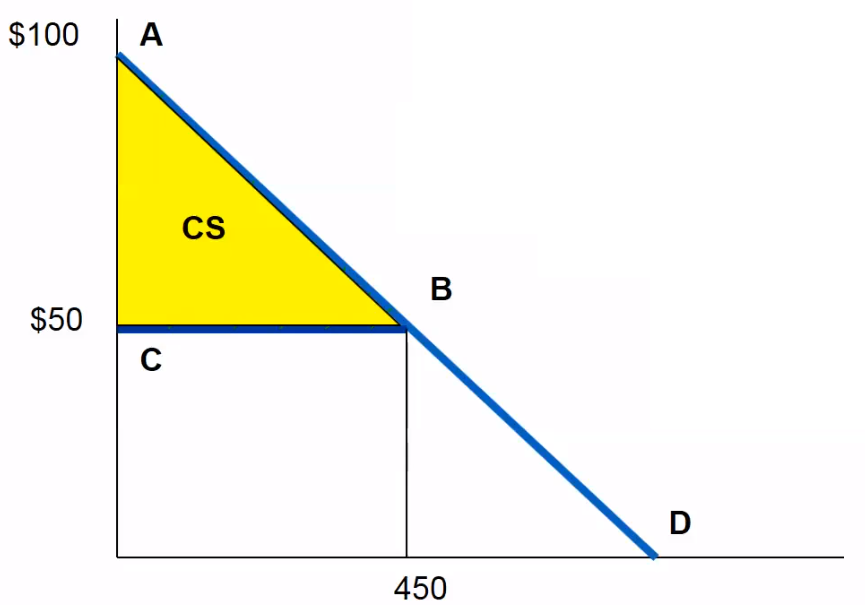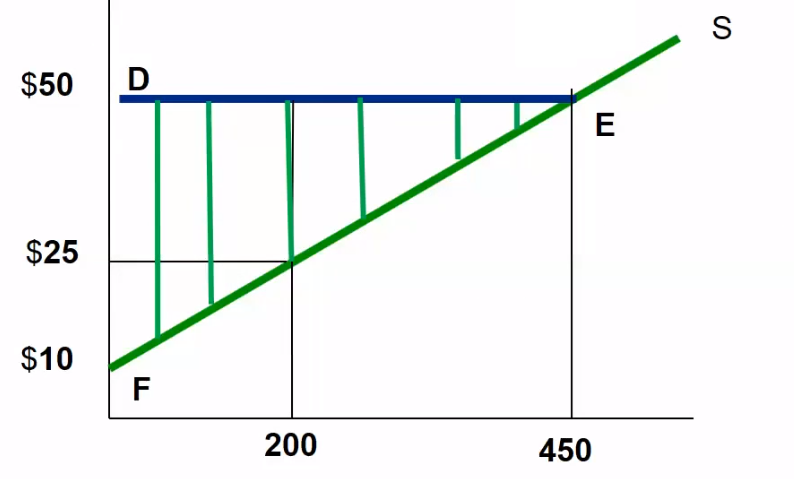Unit 5
| Word | Meaning |
|---|---|
| economic welfare | benefits consumers and firms receive by participating in the market (buying and selling) |
| consumer surplus / CS | the area under the demand curve above the selling price |
| willingness to pay / reservation price | the maximum amount that a buyer will pay for a good |
| willingness to sell / seller's serservation price | the lowest price a supplier will take to produce a good and offer it for sale |
| producer surplus | the benefit a producer receives when the price he receives is greater than his bottom line willingness to sell, the area below the selling price and above the supply curve. |
| total surplus | = consumer surplus + producer surplus = value to buyers - cost to sellers, maximized at equilibrium (so the equilibrium outcome is the efficient outcome) |
| deadweight losses / DWL | a loss in total surplus happens when the quantity traded is less than what would be traded when the market is in competitive equibrium =\frac{1}{2}\times \text{tax per unit} \times (Q_{\text{pre tax}}-Q_{\text{after tax}})  |
| externalities | benefits and costs that arise in the market that go uncompensated |
| positive externality | a benefit enjoyed by individuals even though they did not pay to receive it result in too little production |
| positive externality in consumption | you getting a benefit from something somebody else bought. |
| positive externality in production | you getting a benefit from somebody else doing production. |
| negative externality | a cost suffered by individuals for which they are not compensated result in too much production |
| negative externality in consumption | you suffer from something somebody else bought |
| negative externality in production | you suffer from somebody else doing production |
| marginal private benefit / MPB | maximum price someone would pay to consume one more unit of the good. Generally decreases as more of the good is consumed |
| marginal private cost / marginal cost / MPC / MC | added cost to producers to producing one more unit of the good. |
| when there are no externalities, in the competitive equilibrium MPB = MPC and the market outcome is efficient. when there are externalities that are unaccounted for, the market outcome is not efficient |
|
| marginal social cost / MSC | marginal private cost + externalities |
| internalize (an externality) | e.g. tax offenders to reduce negative externalities / regulate behaviour |
| marginal social benefit / MSB | marginal private benefit + externalities |
| the coase theorem | if private parties can bargain without cost (or very little cost) over the allocation of resources they can solve the externalities problem on their own |
| property right | the exclusive authority to determine how a resource is used, whether that resource is owned by government or by individuals property rights have to be well defined for bargaining to work |
| public goods | goods and services supplied by the public sector, consumers don't need to pay for them |
| excludability | you can prevent someone from using or enjoying the good |
| rivalry | if one person is using or enjoying a good, the ability of someone else to use or enjoy it is diminished |
| free-rider | a person who receives the benefit of a good but avoids paying for it |
| tragedy of the commons | common resources get over used |
| excludable | non-excludable | |
|---|---|---|
| rival | private goods (a donut) | common resources (non-toll highways) |
| non-rival | club goods (cable TV) | public goods (a lighthouse) |
Last update:
October 18, 2021
Created: October 16, 2021
Created: October 16, 2021